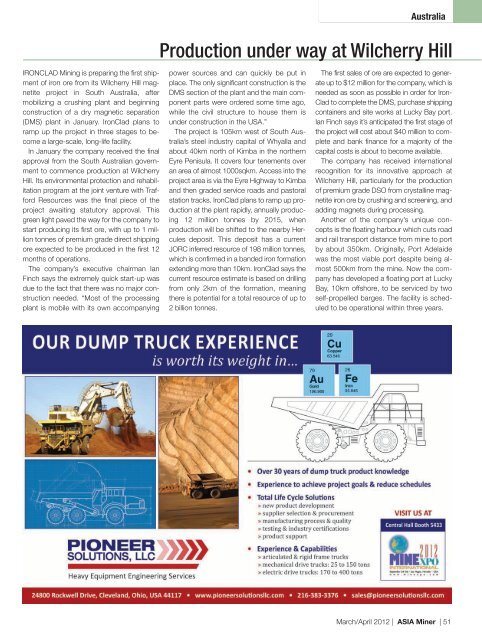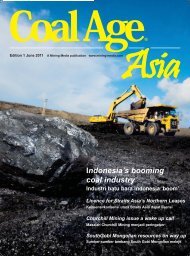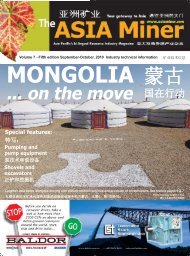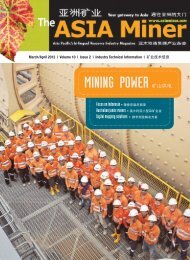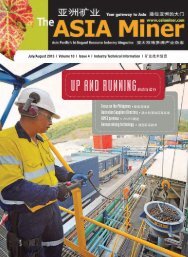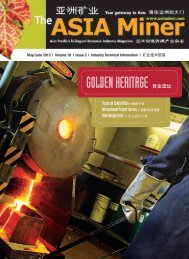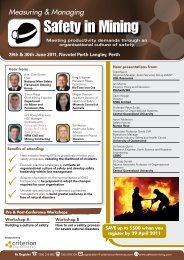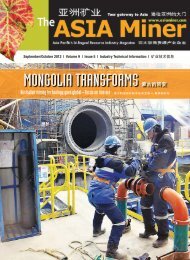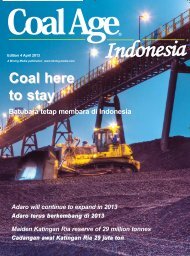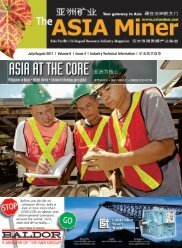Volume 9 Edition 2 2012 - The ASIA Miner
Volume 9 Edition 2 2012 - The ASIA Miner
Volume 9 Edition 2 2012 - The ASIA Miner
Create successful ePaper yourself
Turn your PDF publications into a flip-book with our unique Google optimized e-Paper software.
IRONCLAD Mining is preparing the first shipment<br />
of iron ore from its Wilcherry Hill magnetite<br />
project in South Australia, after<br />
mobilizing a crushing plant and beginning<br />
construction of a dry magnetic separation<br />
(DMS) plant in January. IronClad plans to<br />
ramp up the project in three stages to become<br />
a large-scale, long-life facility.<br />
In January the company received the final<br />
approval from the South Australian government<br />
to commence production at Wilcherry<br />
Hill. Its environmental protection and rehabilitation<br />
program at the joint venture with Trafford<br />
Resources was the final piece of the<br />
project awaiting statutory approval. This<br />
green light paved the way for the company to<br />
start producing its first ore, with up to 1 million<br />
tonnes of premium grade direct shipping<br />
ore expected to be produced in the first 12<br />
months of operations.<br />
<strong>The</strong> company’s executive chairman Ian<br />
Finch says the extremely quick start-up was<br />
due to the fact that there was no major construction<br />
needed. “Most of the processing<br />
plant is mobile with its own accompanying<br />
Australia<br />
Production under way at Wilcherry Hill<br />
power sources and can quickly be put in<br />
place. <strong>The</strong> only significant construction is the<br />
DMS section of the plant and the main component<br />
parts were ordered some time ago,<br />
while the civil structure to house them is<br />
under construction in the USA.”<br />
<strong>The</strong> project is 105km west of South Australia’s<br />
steel industry capital of Whyalla and<br />
about 40km north of Kimba in the northern<br />
Eyre Penisula. It covers four tenements over<br />
an area of almost 1000sqkm. Access into the<br />
project area is via the Eyre Highway to Kimba<br />
and then graded service roads and pastoral<br />
station tracks. IronClad plans to ramp up production<br />
at the plant rapidly, annually producing<br />
12 million tonnes by 2015, when<br />
production will be shifted to the nearby Hercules<br />
deposit. This deposit has a current<br />
JORC inferred resource of 198 million tonnes,<br />
which is confirmed in a banded iron formation<br />
extending more than 10km. IronClad says the<br />
current resource estimate is based on drilling<br />
from only 2km of the formation, meaning<br />
there is potential for a total resource of up to<br />
2 billion tonnes.<br />
<strong>The</strong> first sales of ore are expected to generate<br />
up to $12 million for the company, which is<br />
needed as soon as possible in order for Iron-<br />
Clad to complete the DMS, purchase shipping<br />
containers and site works at Lucky Bay port.<br />
Ian Finch says it’s anticipated the first stage of<br />
the project will cost about $40 million to complete<br />
and bank finance for a majority of the<br />
capital costs is about to become available.<br />
<strong>The</strong> company has received international<br />
recognition for its innovative approach at<br />
Wilcherry Hill, particularly for the production<br />
of premium grade DSO from crystalline magnetite<br />
iron ore by crushing and screening, and<br />
adding magnets during processing.<br />
Another of the company’s unique concepts<br />
is the floating harbour which cuts road<br />
and rail transport distance from mine to port<br />
by about 350km. Originally, Port Adelaide<br />
was the most viable port despite being almost<br />
500km from the mine. Now the company<br />
has developed a floating port at Lucky<br />
Bay, 10km offshore, to be serviced by two<br />
self-propelled barges. <strong>The</strong> facility is scheduled<br />
to be operational within three years.<br />
March/April <strong>2012</strong> | <strong>ASIA</strong> <strong>Miner</strong> | 51


